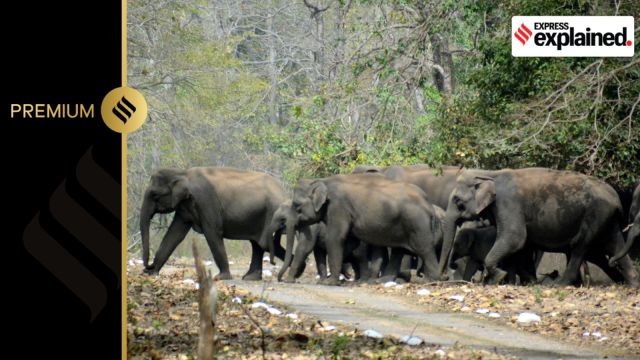The Environment Ministry has shelved its elephant census report, ‘Status of Elephant in India 2022-23’, citing a delay in the census in the Northeast, The Indian Express reported this week. The report on the current status of the national heritage animal in the rest of India has been printed but its release is now on hold until at least June 2025.
Data from the unreleased report show a sharp decline in elephant populations in the east-central and southern landscapes. The slide in numbers is especially dramatic in Southern West Bengal (84%), Jharkhand (64%), Odisha (54%), and Kerala (51%).

The report identifies “mushrooming developmental projects” such as “unmitigated mining and linear infrastructure construction” as a significant threat to the species.
The Environment Ministry has pointed out that the elephant census employed refined methodologies, suggesting that these numbers may not be comparable with the outcomes of previous censuses that have been conducted every five years since the 1990s.
However, the new counting methods may not fully explain the fall in elephant numbers. “The new method based on DNA profiling has not brought down the numbers in the northern (Shivalik Hills and Gangetic Plain) landscape where the latest figure (2,062) closely aligns with the outcome of the previous census (2,096),” a wildlife biologist based in Bengaluru pointed out. “So, the drastic fall in numbers elsewhere can’t be dismissed as a fallout of methodological variation,” the biologist said.
Old counting methods
Until 2002, elephants were counted in India by the “total direct count” method, which means a simple head count of elephants that were sighted. This method has “limited or no scientific basis for large landscapes or populations”, the latest census report says.
In 2002, the “indirect dung count method” was introduced in the southern states. Enumerators walked in pre-designated straight lines through the forest and recorded elephant droppings and the “dung decay rate”. The data were extrapolated to estimate elephant density in an area by factoring in the “defecation rate” of elephants.
Story continues below this ad
Around the same time, the “total direct count” method was modified to “sample block counts” — or a survey of limited areas of 5 sq km each to maximise the probability of detection and enumeration of all elephants in that block. Elephant densities in the surveyed blocks were then extrapolated to estimate populations in larger areas.
Elephants and tigers
On the occasion of World Elephant Day (August 12) in 2021, Environment Minister Bhupender Yadav announced that the government would “harmonise population estimation methods along more scientific lines” by “converging elephant and tiger population estimation” for the first time.
In this method, the entire forest area is broken down into similar-sized cells or blocks (say, A, B, C, and D) where ground surveys are conducted to look for tiger signs (pug marks, droppings, etc.) and identify tiger-occupied forest cells (say, A, B and D).
The survey also assesses a range of “co-variates” — common variable factors such as the quality of vegetation, availability of prey, distance from water/ nightlight, degree of human disturbance etc. — to determine the relative tiger-holding potential of these blocks. For example, if A has the highest tiger potential with a score of 100, the indexed score for B and D could be, say, 75 and 50.
Story continues below this ad
Mark-recapture method
For logistics, camera traps are set up only in a limited area (say, B). After each round of photography, the tigers that are snapped are identified using their unique stripe patterns.
The next step employs the statistical method of “mark-recapture”, which relies on the number of common — recaptured — individual tigers photographed in two consecutive rounds. The bigger the population, the lesser the chances of a tiger being recaptured, and vice versa.
Based on this, estimators derive a tiger number and density (number per 100 sq km) for forest cell B, which is then extrapolated for forest cells A and D where no camera was set up. If, say, the tiger density estimated in B is 12, in A and D, using their co-variate scores, it would be 16 and 8.
The Synchronous All India Elephant Estimation 2022-23 (SAIEE 2023) differed from this tiger census method in only one aspect: it used a genetic mark-recapture model.
Story continues below this ad
The elephant hide has no unique markings like tiger stripes. So elephant dung samples collected during ground surveys were analysed in the lab to identify unique elephants by differentiating individuals based on eleven microsatellite loci (genetic markers).
Why the delay hurts
Irrespective of the refinement in census methodology and the delay caused by logistical limitations, the results that are already available should not be held back, experts said. “This helps neither science nor governance. This is precious data obtained by spending public money. The five-year census cycle is overdue. There is no reason why available data should not be in the public domain and guide policies,” a former member of the Environment Ministry’s National Board for Wildlife said.
An elephant researcher familiar with the census efforts in Assam and Arunachal Pradesh said the Northeast numbers are unlikely to salvage the downward trend. “If modelled correctly, the results from the Northeast will also show a 20-25% fall or correction, whatever you call it. The government is only buying time,” he said.
A retired forest officer from Odisha said the delay could prove costly for elephant populations in distress. “While habitat loss and conflict are common threats to elephants across India, certain risks are landscape-specific. In Odisha, for example, it is mining and low-hanging power lines. The drastic fall in our elephant numbers should have triggered intervention by now,” he said.
Story continues below this ad
Why the numbers matter
In 2023, Karnataka, Tamil Nadu, and Kerala used a protocol combining the block count and dung count methods, which, the unreleased report said, “finds corroboration through genetic mark-recapture methods used in SAIEE 2023” — suggesting its potential scalability for future large-scale adoption in combination with genetic mark-recapture in selected sites.
The 2017 elephant census report had underlined why it was “desirable to maintain some level of continuity with the previous population estimations to make a meaningful comparison with past figures to infer broad trends”.
Absolute numbers for elephants or tigers have no meaning beyond news headlines, a senior forest officer from Karnataka said. “We estimate populations to know how a species is doing in the wild. So continuity is important for comparison. When we claim to have drastically improved the method, we have to accept the new baseline data as a reality check without worrying about the optics.”








































